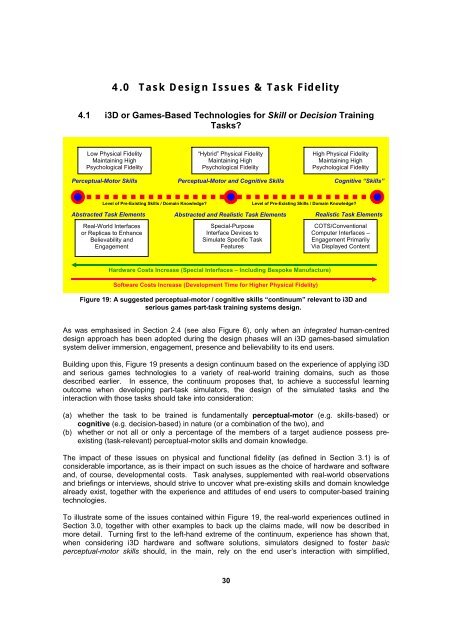Human Factors Guidelines for Interactive 3D and Games-Based ...
Human Factors Guidelines for Interactive 3D and Games-Based ...
Human Factors Guidelines for Interactive 3D and Games-Based ...
You also want an ePaper? Increase the reach of your titles
YUMPU automatically turns print PDFs into web optimized ePapers that Google loves.
4.0 Task Design Issues & Task Fidelity<br />
4.1 i<strong>3D</strong> or <strong>Games</strong>-<strong>Based</strong> Technologies <strong>for</strong> Skill or Decision Training<br />
Tasks?<br />
Low Physical Fidelity<br />
Maintaining High<br />
Psychological Fidelity<br />
Real-World Interfaces<br />
or Replicas to Enhance<br />
Believability <strong>and</strong><br />
Engagement<br />
“Hybrid” Physical Fidelity<br />
Maintaining High<br />
Psychological Fidelity<br />
As was emphasised in Section 2.4 (see also Figure 6), only when an integrated human-centred<br />
design approach has been adopted during the design phases will an i<strong>3D</strong> games-based simulation<br />
system deliver immersion, engagement, presence <strong>and</strong> believability to its end users.<br />
Building upon this, Figure 19 presents a design continuum based on the experience of applying i<strong>3D</strong><br />
<strong>and</strong> serious games technologies to a variety of real-world training domains, such as those<br />
described earlier. In essence, the continuum proposes that, to achieve a successful learning<br />
outcome when developing part-task simulators, the design of the simulated tasks <strong>and</strong> the<br />
interaction with those tasks should take into consideration:<br />
(a) whether the task to be trained is fundamentally perceptual-motor (e.g. skills-based) or<br />
cognitive (e.g. decision-based) in nature (or a combination of the two), <strong>and</strong><br />
(b) whether or not all or only a percentage of the members of a target audience possess preexisting<br />
(task-relevant) perceptual-motor skills <strong>and</strong> domain knowledge.<br />
The impact of these issues on physical <strong>and</strong> functional fidelity (as defined in Section 3.1) is of<br />
considerable importance, as is their impact on such issues as the choice of hardware <strong>and</strong> software<br />
<strong>and</strong>, of course, developmental costs. Task analyses, supplemented with real-world observations<br />
<strong>and</strong> briefings or interviews, should strive to uncover what pre-existing skills <strong>and</strong> domain knowledge<br />
already exist, together with the experience <strong>and</strong> attitudes of end users to computer-based training<br />
technologies.<br />
To illustrate some of the issues contained within Figure 19, the real-world experiences outlined in<br />
Section 3.0, together with other examples to back up the claims made, will now be described in<br />
more detail. Turning first to the left-h<strong>and</strong> extreme of the continuum, experience has shown that,<br />
when considering i<strong>3D</strong> hardware <strong>and</strong> software solutions, simulators designed to foster basic<br />
perceptual-motor skills should, in the main, rely on the end user’s interaction with simplified,<br />
30<br />
High Physical Fidelity<br />
Maintaining High<br />
Psychological Fidelity<br />
Perceptual-Motor Skills Perceptual-Motor <strong>and</strong> Cognitive Skills<br />
Cognitive “Skills”<br />
Level of Pre-Existing Skills / Domain Knowledge? Level of Pre-Existing Skills / Domain Knowledge?<br />
Abstracted Task Elements Abstracted <strong>and</strong> Realistic Task Elements Realistic Task Elements<br />
Special-Purpose<br />
Interface Devices to<br />
Simulate Specific Task<br />
Features<br />
Hardware Costs Increase (Special Interfaces – Including Bespoke Manufacture)<br />
Software Costs Increase (Development Time <strong>for</strong> Higher Physical Fidelity)<br />
COTS/Conventional<br />
Computer Interfaces –<br />
Engagement Primarily<br />
Via Displayed Content<br />
Figure 19: A suggested perceptual-motor / cognitive skills “continuum” relevant to i<strong>3D</strong> <strong>and</strong><br />
serious games part-task training systems design.







![Benyamin Asadipour-Farsani [EngD Conference abstract]](https://img.yumpu.com/51622940/1/184x260/benyamin-asadipour-farsani-engd-conference-abstract.jpg?quality=85)









